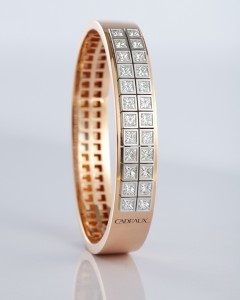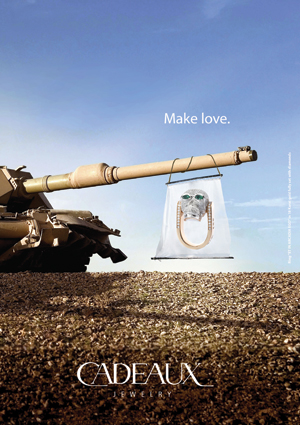Historically jewelry has served to represent identity, reflecting personality, power and rank, and it has been linked with spirituality and believed to provide fortune, power and protection. The importance of these functions has justified the use of the most valuable and precious metals and gemstones and their transformation into jewels using the finest and most creative crafts.

Cadeaux Jewelry Bangle Berlin
Modernism is a stylistic development in art, architecture and product design that is governed by functional and essential formalism. It has its roots in the late 19th and early 20th century and subjugates craftsmanship and heretoforth predominant decorative purpose to the rationalisation of function, production and distribution. It goes hand in hand with an increasingly horizontal orientation of societies and with a broadening of demand. Modernism seeks simplified and standardised forms that are determined by use and function, and it factors in the the exigencies of mass-production and broad distribution. Designs become multiplicable and clean-lined with a consistent identity suitable to modern production techniques that employ more practical and newly developed materials.
A wider base of wealth and broader political rights in the 20th century, particularly in the West, mean jewelry can no longer serve as an exclusive symbol for the privilege of aristocracy. Its function as symbol of rank changes into a a more complex and multi-facetted function as symbol of hedonism, lifestyle, affinity, individualistic statement and fashionable decoration. Only in partial aspects does jewelry maintain its traditional materialistic distinction, though interestingly it continues its traditional purpose as alternative material and personal storage of value.
Jacques Herzog of Herzog & de Meuron architects, the company that developed the Olympic Stadium in Beijing (2008) and many other iconic international architectural projects, classifies modernism as an equalising, democratic movement, that rather makes one city look like the next in terms of architectural development. Also for jewelry, the aspects of standardisation, identification, broad distribution and mass-production have had equalising and democratic influences on jewelry. Individual identity has been substituted by a standardised brand identity being more driven by name than by distinctive, rare or even unique materials and exclusive craftsmanship. Accordingly jewelry has become more affordable and definitely more widely available.
Modernism dares to question what the practical purpose of formal beauty is in a commonplace object and what values it should communicate. Under this challenge, jewelry wanes in its role as a traditional signal of rank and seeks a more contemporary function as an expression of personality, as a medium of communication for personal taste, knowledge and values. Hedonistic aspects, emotion and tactility intensify the need for jewelry to please the senses and satisfy desires, while no longer communicating only to the outside but also to the inside, to the wearer, the self, the ego. Identity becomes conscious self-assertion and a new tribal association with present-day values and perceptions.

Beauty is no longer associated with traditional rank or with modernist branding, but radiates from manifest self-identity, the displayed self-confidence of the wearer. A new iconomania seeks a more individualistic exclusivity, a shout-out, an individual jewelry identity.
Jacques Herzog, talking from the vantage point of architecture, suggests modernism is enmeshed in the functionality and conceptualization of space, iconomania stylistically seeks distinction and attraction in it’s own right. However, Jacques points to the danger of the creative process becoming enslaved by the demands off iconomania. The requirement to create an icon reduces the creative freedom. The expectation that one iconic idea outdo another, alienates the creative process from a functional goal.
In jewelry, functional limits are determined by wearability. However, they are often broader than conventional thinking suggests. Thus iconomania allows a scope of experimentation that veers far from the formalistic constraints of modernism, but functionality is all the better maintained the more a development has its roots in modernism and in the basic functionality of a jewelry item, even while exploring iconic ideas that follow the development of expressive and individualistic jewelry.
Cadeaux Jewelry – established in 1975 by a professional sculptor – emerges from a deep sensitivity for modernism and with a purpose to create a jewelry identity individual to the wearer. In the 70s, the serious adaptation of modernistic principles in jewelry is avant-garde. Cadeaux Jewelry’s significant creations capture the Zeitgeist of an ideal notion-of-form that collectors and designers appreciate and continue to admire to this day.
As Cadeaux Jewelry adapts its creativity to more iconic trends in the 21st century, well-established neo-classical concepts prevail, underlying a contemporary and more playful iconography that attracts the senses and explores the needs and values of modern-day individual expression.
[Sources: Interview of Jacques Herzog by Hans Ulrich Obrist and Ezra Petronio, published in DU 852, December 2014 / January 2015, Zürich (Pages 60-67).]